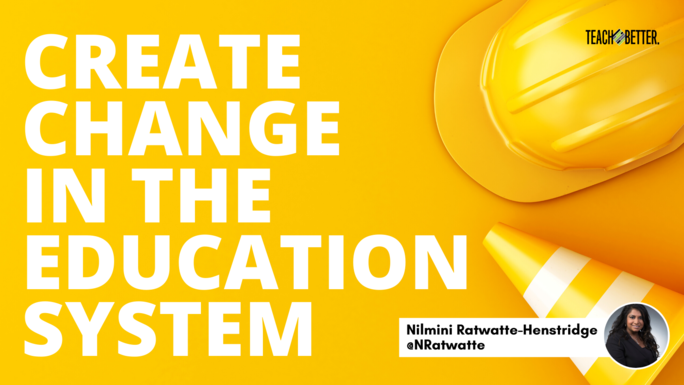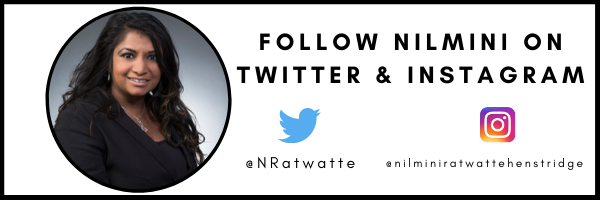TL;DR:
- Educators have a responsibility to teach anti-racist perspectives.
- Create change in the education system by seeing skin color. Give a voice to individuals from diverse backgrounds in the field of education.
- All educational spaces and systems need to move towards change and learn and adapt to bring about systemic changes.
As a lifelong learner, as a BROWN educator, it was invaluable for me to be able learn by taking the time to reflect on how to create change in the education system. As I navigate my brown privilege, in holding my voice and my actions accountable while finding a safe space to create change in education system, I decided to write as an elementary teacher.
Here is hoping to build alliances from many communities of brown individuals, alongside colleagues in education of all cultural heritage who stand together to create a movement.
Together empower the next generation to make a movement toward systemic change for all Canadians and all educators globally reading this blog. Click To TweetSystemic Discrimination, Race Relations in Education
Historically, education systems have never served and have failed Black or Indigenous students, according to current research. As we find ourselves in this courageous conversation, we get to pass as having brown privilege as we navigate social and professional spaces.
Important to see SKIN color!
THIS IS KEY!
You have to see me as a BROWN educator! It is that simple. If you can’t see my skin colour, you can’t give the space nor hear my voice since it does tell a story of where I come from and of my heritage. This is important when giving a voice to individuals from diverse backgrounds in the field of education.
Considerations:
- How do we uphold white privilege as a brown person?
- Is there such a thing as brown fragility?
- We know there is a concept of white fragility. How does this come into the classroom setting?
- Conversation is reactionary and collectively there is a challenge to make inclusive spaces in education.
- What does anti-Blackness look like in Ontario’s education system? In your classroom? In your school system?
- How do we stand up, speak with Black students? How do we shift our view to white privilege instead of not speaking about anti-Black racism?
- Colonial System: How do we push the Black students out of the system? And how do we stop this from continuing?
- How are we complicit with anti-Blackness to the harm and detriment of Black children?
- Think about whiteness; how does it operate in our bodies as brown people?
What does it mean to be Brown vs. South Asian?
South Asian Diaspora around the world: first, second, third generations of people who have immigrated, or individuals who have come as refugees to North America, and have become citizens. We have complex identities on how we view this world we navigate through casteism and shadeism: implication to prosperity, access to resources, education, privilege, and as we settle we bring ideas with us.
As Brown people, we continue to experience racism. We are invisible in media and do not exist in textbooks. We are ignored for the most part since we are “new” to movies, TV, and media. And we are seeking to hold roles in leadership. Caught between worlds: home vs. here; own experiences of oppression and lived experiences of reality.
That’s why we need to be BROWN so we are united we all can build alliances to make changes.
Colonialism World History
A word that does not need a definition: since it is our WORLD history lesson in a nutshell. It pushed the idea of a racial hierarchy so that we can be divided and controlled and uphold white values and systems of oppression.
What does that mean to us as brown person, global citizen, and as an educator?
“The system” does not want to change or challenge the status quo of a racist system that is operating. This continues through the organization to maintain the status quo and keep a system in play such as the school system that we teach in.
We as brown people owe being here to Black people and communities who have made changes to the Racial Discriminatory Act, Human Rights Code, and continue to organize. We learn from people who made a difference before us to continue and join in the movement.
Why say “Sri Lankan” when describing the Diaspora?
An important consideration since this past year, many communities were in conflict with each other by trying to separate the individuals with a Sri Lankan heritage. I was born in Sri Lanka, a beautiful island that was torn apart from racist beliefs that caused a civil war that lasted many generations. My entire life I never thought PEACE could have been achieved, though it came at a great cost of loss of human life. I wanted to take a moment to reflect on the importance of educating ourselves from a global perspective.
In this generation, we have a responsibility to get along, find common grounds, hold and teach anti-racist perspectives.
No matter what cultural heritage we are since we now live towards a peaceful world, it is our responsibility to be united as a diaspora. This is our time and we stick together: finding common ground.
“In Canada/United States acknowledging our settler status so that we can building trusting relationships as a community after an end of an armed conflict, we can work together towards the Rights of the Indigenous People in Canadian/American history.”
“By Sri Lankan Heritage: Mixed heritage Canadians/American who identify as Sri Lankan, Sinhala, Tamil, Muslim, Malay and Burgher Diaspora in Canada as we settle on the land and make it our home as shared by the treaty of Indigenous peoples of Canada.” We are inclusive this way, not racist by separation and falling back to separation and division that was created by colonialism. We can say “Canadian-Sri Lankan heritage citizens” (American-Sri Lankan heritage citizens) perhaps so that we can be reflective of the diversity of the diaspora.
This can also apply to all countries as cultures mix to learn to hold on to their cultural heritage while being citizens of their new homeland. It’s that feeling of always trying to fit in and wanting to belong, and always figuring out that you do not really fit in since you have outgrown your own culture because you live in a new world. But you don’t fit into your new culture since you are holding on to your culture so you can pass it to the next generation.
A global perspective: we are human, after all, and it is important not to display and perpetuate racism. Rather, see the world through a peaceful eye to maintain unity and collaboration.
Teaching for Diversity
Within racism, there are different forms of racism. If we talk too much or campaign too much, we are shut down but held to a higher power; minorities work in their own sections, in our own bubbles! These are our own safe spaces.
I have learned that it is important to claim a safe space.
Do not let the brown fragility operating in a white supremacist system take over when working in education and call out racism. Thoughts?
The daily experience of a Black student or child coming into a school system was an important consideration for me when I decided to take on the work…
Being BROWN: How do we navigate through spaces in our world?
- Relationships we have in a school.
- Student discipline.
- Curriculum and instructional strategies.
- Hiring, retention, and promotion process.
- Other systems and structures that function within the education system.
- What about the reactions of the individuals in the system holding power? It is important to consider the backlash/consequences/importance of being resilient as an educator.

What about holding people to account?
All educational spaces and systems need to move towards change and learn and adapt to bring about systemic changes. We need to call them Canadian spaces for all students so that they are successful in our classroom.
Be transparent.
Be accountable.
Create alliances.
Create success for students!
Educators can show up to learn, unlearn, and make a change as we continue to act collectively and transform public education as educators because we know we are stronger together.
Yours in Education,
Nilmini
References
“Brown Complicity in White Supremacy Towards Solidarity with Black Lives” Webinar Presented on Friday June 19th 2020.
Moderators/Co-learners: Sultan Rana and Sayema Chowdhury (The Educators Faculty at the of Education York University, Canada).
Research Credits
Jeewan Channioka (CEO Superintendent of a Network of American Group of Schools based out of Dubai)
Vidya Shah (Assistant Professor at the Faculty of Education York University)
Herveen Singh (Assistant professor at the Faculty of Education Ziad University)
About Nilmini Ratwatte-Henstridge
Nilmini Ratwatte-Henstridge teaches in Brampton, Ontario, Canada. She was born in Sri Lanka and immigrated to Canada with her family. As an Elementary School Teacher who is passionate about Equity, Social Justice, and Human Rights in education she enjoys teaching the younger generation to be global-minded citizens.
Discovering the world by connecting with others is an opportunity that we have today in our society today and she loves meeting new people! She is always learning while traveling to understand the inter-connectedness of this beautiful earth we live in! Nilmini LOVES Cooking great meals, Watching movies, and the latest fashion trends! Family and friends are close to her heart as she looks forward to balancing social media and navigating professional learning communities in education to network globally this year!



